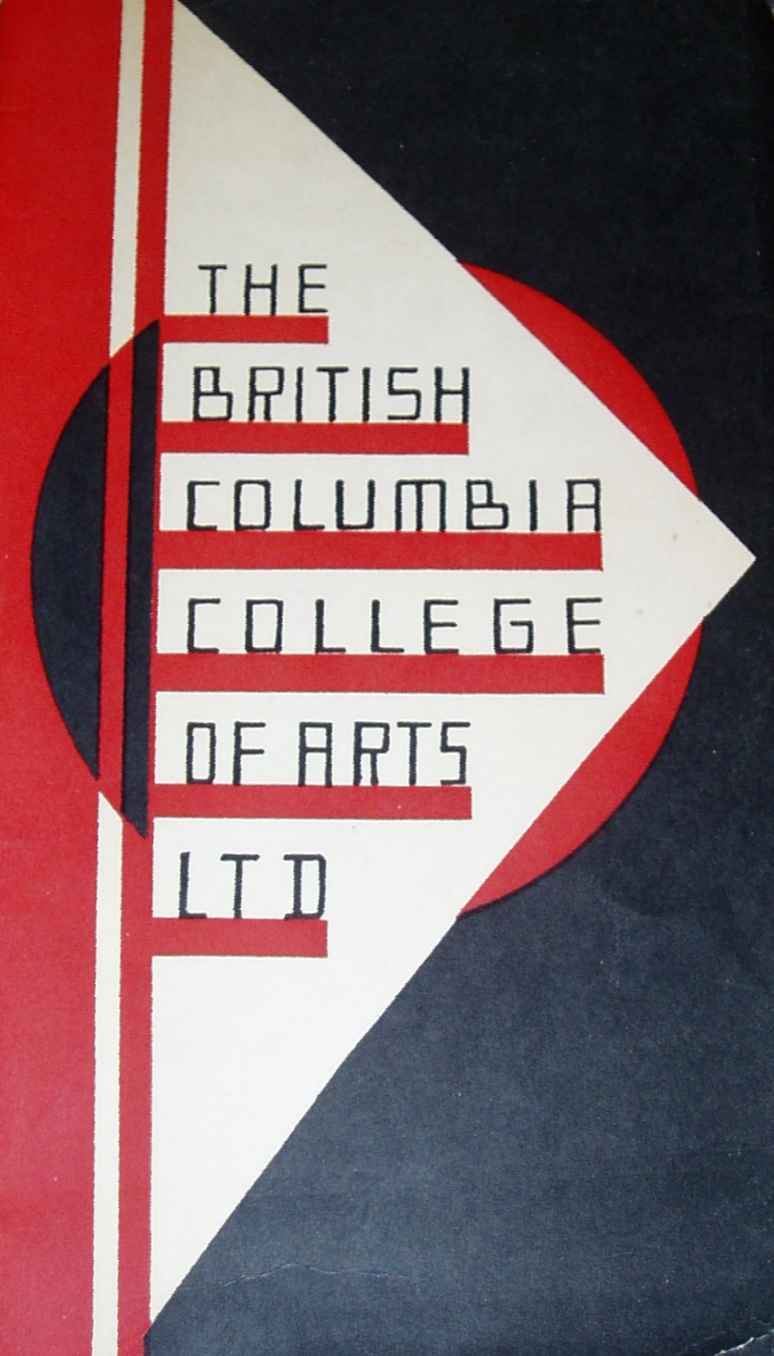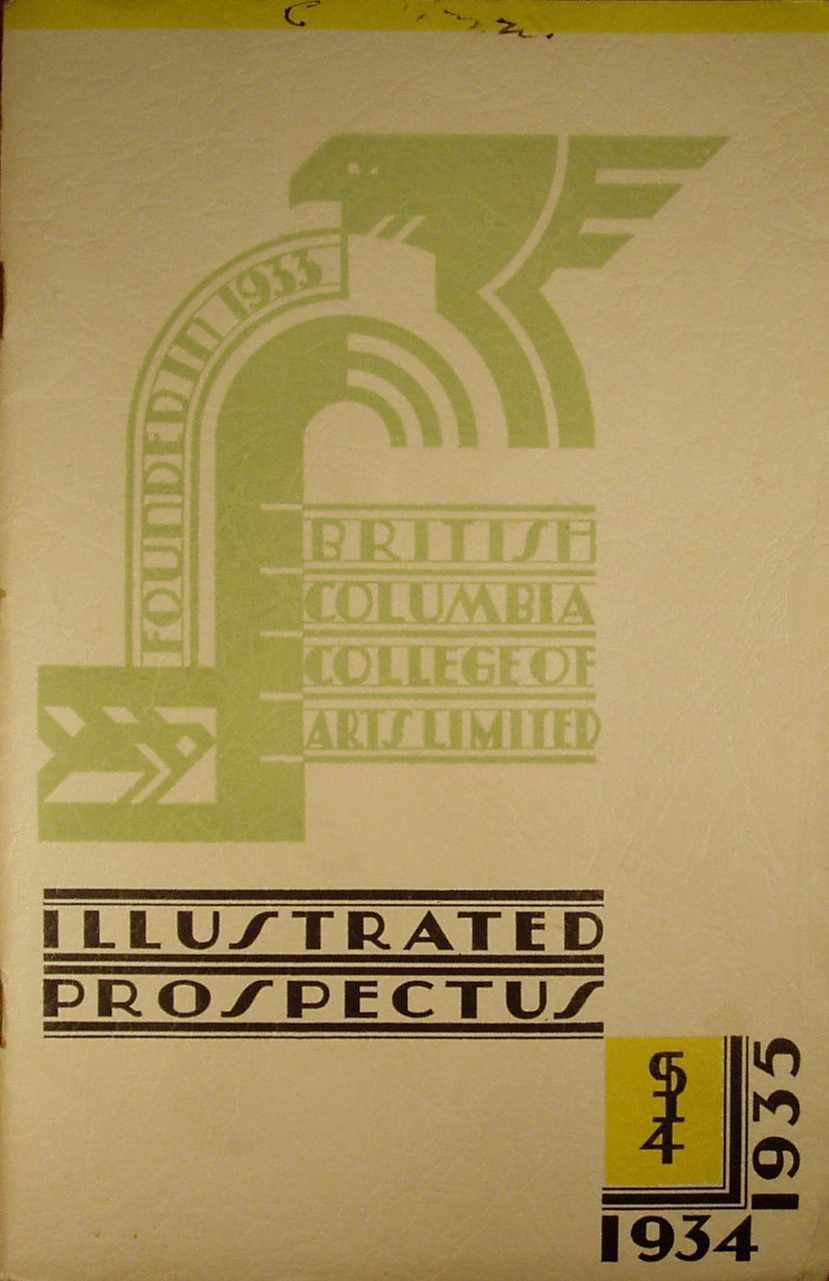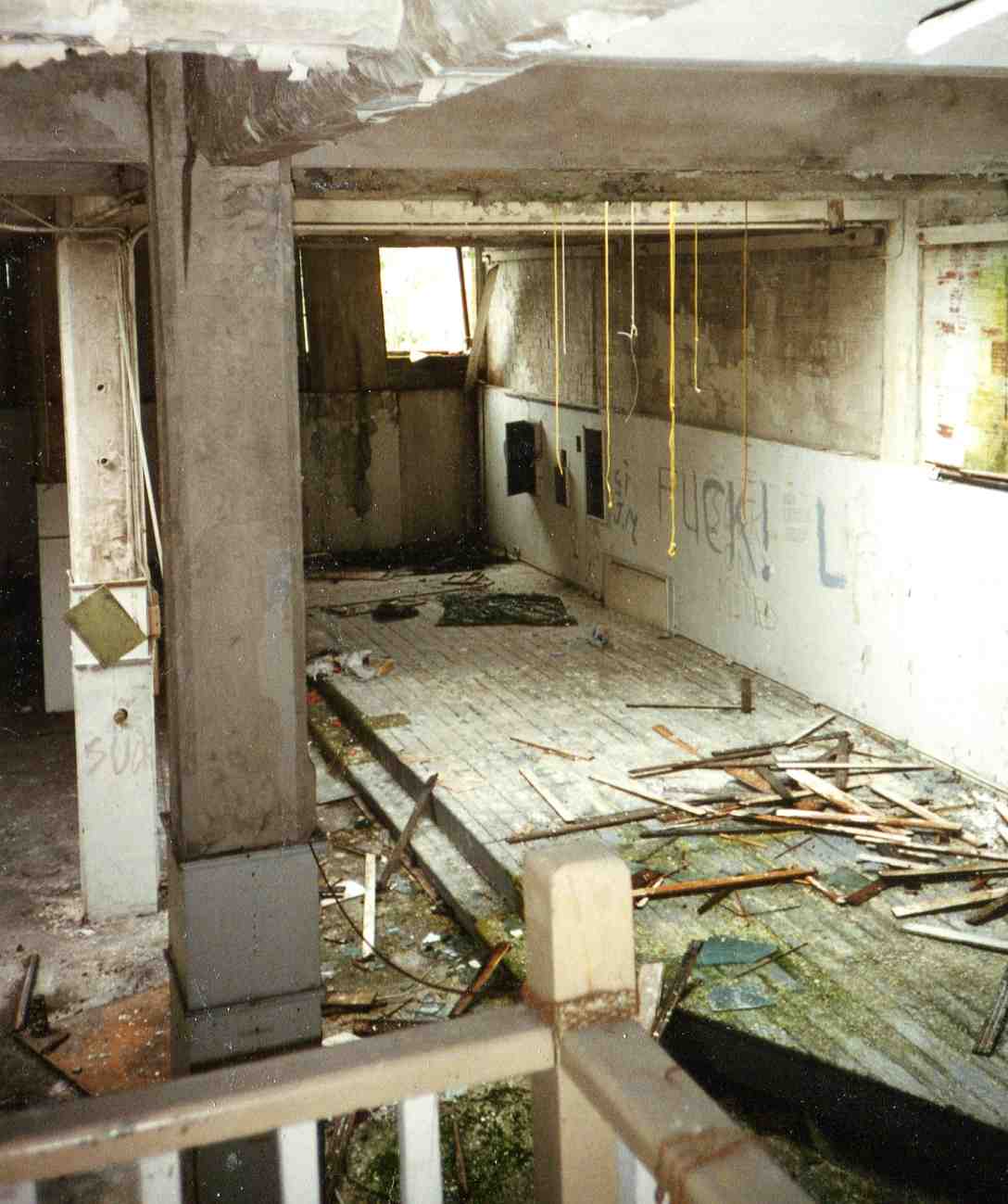

Prospectii covers, 1933-34 & 1934-1935
Home Publications Artwork News Links About


I had no idea that Varley had ever been a teacher. I knew that he was a member of the Group of Seven, and was one of the more famous Canadian painters. As far as I knew he didn’t have any connection to Vancouver at all. So, where to begin?
At this point, I had no idea how much time I was going to spend on the project. I was buying and selling paintings regularly, this was just another painting of many...I probably did a search on the Internet for “Maud Sherman” with no hits, but I can’t clearly remember. I wasn’t recording of any of my activities specific to this painting at that time.
So, with little overall thought about the matter, and with little experience in the many places to mine information in Vancouver (and how to mine it), I decided to look for information about where Varley might have taught. By finding this information, I hoped to find some record of Maud being taught by Varley.
I had recently discovered Carillon Books on Howe Street (since demolished and currently available on the Internet through www.abe.com). They specialize in books on Art, Architecture, and Music. One day after work, I walked over there to rummage around their collection of art books, with a specific eye for Varley information. I talked to George Carroll, the proprietor, about my specific interest, and he suggested that a copy of Vancouver: Art and Artists, 1931 -1983 might have some information of interest to me. The book was issued by the Vancouver Art Gallery, as part of “an inaugural exhibition in celebration of the opening of the new Vancouver Art Gallery at Robson Square” in 1983, following their move from Georgia Street.
I leafed through the book, and was immediately hooked. Frederick Horsman Varley had taught art school in Vancouver! He’d joined the staff of the Vancouver School of Decorative and Applied Arts (later renamed as the Vancouver School of Art, and now Emily Carr Institute) at the start of its second year in September 1926. He taught there until leaving to help found the B.C. College of Art in September 1933. The College had been located at 1233 West Georgia Street, Vancouver, in a building which had originally been a motor car showroom and garage. I sat bolt upright in surprise!
I was living barely three blocks away from the College’s old location! I could hardly believe it. How could I know so little about Vancouver? I tried to visualize the location....the north side of Georgia Street, between Bute Street and Jervis...the Banff apartments on the corner of Georgia and Bute, then the old Maynard’s auction building to the west, then a parking lot, and a mid-rise office tower at the other end of the block. It was late in the evening by this time, and I determined to look for the building the next day on my way to work, since it would be only a half block out of my way.

I was partly amazed that the building was still there, and partly that I had known the building for many years without knowing its past. Maynard’s had simply been one of the more recent occupants of the building. In 1972 I had actually lived across the back lane from it in the top rear apartment of 1220 Melville Street, and from the back porch I had been able to see into the building through the large northern windows of 1233 Georgia.
I appraised the situation. The building was partially burned down, the north-west corner of it clearly open to the rain. The plywood hoarding looked a little feeble. In fact, one whole 4 x 8 panel looked like it wasn’t really attached at all. I looked around. It was about 8:40 a.m., rush hour on Georgia Street. It was overcast, with a light drizzle. There were three full lanes of traffic inbound to Vancouver, and a scattering of cars heading west. I was standing just behind a bus stop shelter, somewhat hidden from the street. I stepped over to the hoarding and pulled one edge of the plywood. It swung open towards me like a door. My adrenaline surged as I realized that I could walk right in to the building. The idea of that illicit thrill suddenly became irresistible, and I decided to go in for a look.
I took another look around me. There was no-one at the bus stop, but the light was red on Georgia Street at Bute and some rush-hour traffic was backing up momentarily. I idled about for a few seconds, trying to look like I was waiting for a bus. The light changed, the traffic rushed off, and things went quiet. I quickly swung open the plywood ‘door’, and stepped through the 2 x 4 framing. As I did this, the universe seemed to shift slightly on its axis, I seemed to feel a slight momentary dizziness as it spun. I was clearly well off my normal course. The plywood panel swung shut behind me.

The building was clearly derelict, and the new hoarding promised demolition soon. Running from Georgia Street back to the lane, and about one hundred feet wide, the building’s main floor fronted level with Georgia Street, there was also an upper storey, and a basement that was level with the lane at the back. There was a lot of space in the building for undesirable company to be occupying. The interior was much brighter than I expected, and at first I thought that much more of the roof had been burned out than was visible from the sidewalk.
I walked cautiously forward. Although there was a lot of garbage strewn around, the concrete floor seemed sound, so I didn’t have to worry about suddenly plunging through some rotten boards and disappearing into the basement to be found sometime later when they tore the building down. A mound of garbage piled on the stairs to the upper floor blocked easy access to that part of the building, but no stairs to the basement were visible from where I was standing. Walking through the lobby, I entered the main room, and the reason for the well-lit interior became clear. Not only was part of the roof burned out, but there were a number of large skylights in the roof.
Most of the glass was broken out of them, and the light drizzle was dripping through onto the concrete floor below. Moss and ferns were growing out of bits of rotting carpet and underlay on the floor. It was quite a strange feeling, standing in a dead building of that size. Working as an architectural draftsman, I was much more involved in the creation of new buildings, or alterations to ‘living’ buildings. This was a building in name only, a ghost of its former glories now rotting back into the ground.
I took a quick look around, and then decided to leave the building and go to work. I was dressed for the office, and the building was too wet and dirty to explore further, especially with soot from the fire all over the floor. Returning to the front entrance, I slipped out through the plywood ‘door’. Suddenly, I was back in rush hour in downtown. Everything was clean and shiny and bright. New, complete, normal. A person standing in the bus shelter looked at me in surprise, wondering where I had suddenly appeared from. I walked away nonchalantly, acting like they’d simply missed seeing me walk up the sidewalk.
After work, I went home and looked through ‘Vancouver: Art and Artists” again. Photographs of the building in its prime were on pages 19, 59, 60. The photograph on page 60 showed the Graduation Ceremonies at the B.C. College of Arts c. 1934-35. In it, J.W.G. MacDonald and F.H. Varley are on a platform, along with the rest of the school’s staff, and there are numerous paintings on the walls behind them. I had just been standing on the same spot they were standing in the picture. The basic structure of the building was clearly identical.


This was rather difficult, since the old balcony was tilting downwards, and was almost completely disconnected from the wall. I didn’t step onto it, but took the pictures from the safety of the doorway behind it. Then I went downstairs, and located the door to the basement. It was blocked by a large pipe slung in front of it, so I didn’t try to open the door. Feeling that I had made some progress in satisfying my curiosity, I left the building and went to work.
The next morning, Saturday, I made a somewhat more serious expedition to the building. Wearing work boots and jeans, and adding a flashlight to my expedition gear, I explored the upstairs some more, and rummaged through the garbage on the stairs a little trying to determine how old it was, and hoping to perhaps find a bit of old art school treasure. Well, that didn’t work out too well, although I did find a pair of silver-plated forks.
I went to the door to the basement, and moved the pipe out of the way. The door was spray-painted with the words "WORM HOLE" in large letters. The door knobs had been removed from the door, so I wasn’t sure if it would open. I gave it a push and it swung open. To my surprise, in front of me there was an wide, elegant concrete staircase descending to the basement. There were about fifteen steps going down to a large landing, and then the stairs reversed back and disappeared into the darkness below. I couldn’t see the bottom steps. Numerous sooty footprints were visible on the stairs. From below, there was the faint sound of water dripping and echoing. My nerve failed for a moment. Then I determined to descend. Push the limits. Explore dark corners. Become a thorough researcher, leaving no lead unturned.
Stepping onto the top landing of the stairs, I lightly closed the door behind me in case someone came in to the main floor the same way I did. The door wouldn’t stay shut. I pushed a little harder, but with the door knobs gone it wouldn’t stay shut. Pushing against it harder yet, the door suddenly jammed shut. Oh, perfect! I gave it as good a tug as I could with a couple of fingers in the doorknob hole, but now it wouldn’t open. I stopped and stood still for a moment. It was almost pitch black, just a dim ray of light coming through the hole in the door.
I pulled out my little pocket flashlight and turned it on. I decided to go down and explore the basement, and worry about the door later, reasoning that there was probably a way out from the basement to the lane, if I needed one. Working up my nerve, I descended a few stairs, and stopped. Listened. Only the sound of dripping water...Vancouver water torture. I yelled, “anyone here?” Only echoes answered me. Well, what did I expect? Anyone lurking down in the basement would probably be having difficulty stopping themselves from laughing at this point, and certainly wouldn’t reply “no, no-one’s here”.
I descended the stairs into the black. When I reached the landing, I shone my pocket flashlight down into the basement below. It was just a huge open space divided by columns holding up the main floor. Puddles of water reflected the flashlight’s feeble glow. There was lots of office garbage and junk. No sign of anyone hiding there, but a number of ‘nests’ showed that people had slept there. I wandered around, but found nothing of interest. I found the old boiler room, with the boiler still in it. I took a picture of it, for the first time utilizing my pocket camera’s ability to take pictures in the dark. When there’s not enough light, it emits an beam of light that allows it to use the autofocus.
I made my way to the back of the building beside the lane, and discovered that the back wall of the building was quite lightly constructed in wood strips, and I could simply kick my way out through it if I needed to. I went back up the stairs to try the door again. I stuck my strongest finger from each hand into the hole in the door, and gave it a quick hard tug. It opened and I was free. I returned the pipe to its position blocking the door, and left the building for good. If there were any hidden art treasures in the building, I didn’t find them. I wanted to take the pane of glass from over the door, since it had the number 1233 painted on it (perhaps a Varley...) but I couldn’t bring myself to actually take part in vandalizing the building. Perhaps I should have, a few days later someone had thrown a rock through it, and it was lost forever.
I was laid off shortly after that, and started walking a different route to my new job. The next time I went by 1233 a few weeks later it was mostly just a hole in the ground. A high-hoe was just ripping down the last bit of its basement wall alongside the Banff Apartments. A few months later a shiny new high-rise stood on the spot.
I later matted one of the pictures of the outside of the building, and donated it as one of three door prizes at the Vancouver Writer’s (and Reader’s) Festival Volunteer Party. One of people there saw it and told me that his father had been one of the original car salesmen at the building when it was built and first opened as a car showroom in the early 1920’s.
I later came across an advertisement for the car dealer in the Province newspaper, September 20, 1921. The Consolidated Motor Company was selling Packards, their slogan “ask the man who owns one”. The Single-Six was selling for $4,600.00 f.o.b. factory, and promised “a yearly average of 17 miles or better to the gallon of gasoline, 2,000 miles or better to the gallon of oil, and 15,000 miles or better from tires”. You could telephone them at DOUGLAS 701.
Although the entire 1233 episode gave me no direct progress in looking for Maud, other than a taste for adventure and firsthand knowledge of a place where Varley had taught, I reaped immense indirect benefits from the experience. I had learned a couple of valuable things.
Firstly, that some of Vancouver’s history is still out there, waiting to be found...before it disappears. The photographs I took from the second floor balcony, matching those of the 1934-35 graduation ceremonies, can’t be replaced. The building is gone. Even the excellent new age artwork on the hoarding is gone...I wonder if the anonymous spray paint artist, interpreting with great skill the array of posters plastered on the plywood advertising the Group of Seven show at the Vancouver Art Gallery, had any idea that he was painting on the front door of Varley and MacDonald’s old school? Were their ghosts there, watching and trying to critique his work?
Secondly, I learned that no research lead, however feeble, can necessarily be written off without investigation. Even the faintest of trails can lead to incredible ‘new’ discoveries, as I found out some time later. It pays to write down every little detail, even when they don’t make sense, because they are all part of the overall picture.
I now had some pieces of the picture...Varley had taught in Vancouver at two art schools...the British Columbia College of Arts Limited on Georgia Street, now long closed down, and the other, earlier Vancouver School of Decorative and Applied Arts. I had discovered some information about the College of Arts, although nothing linked to Maud Sherman, so I decided to investigate the School of Decorative and Applied Arts - what was that all about?